Take a look at our selection of hot new releases and popular kids' books and let us know which titles and covers catch your eyes. There are so many amazing new kids books coming in 2016!
Add a CommentViewing: Blog Posts Tagged with: Philip Reeve, Most Recent at Top [Help]
Results 1 - 25 of 46
Blog: The Children's Book Review (Login to Add to MyJacketFlap)
JacketFlap tags: Mary Pope Osborne, Philip Reeve, Linda Ashman, Hillary Rodham Clinton, Nicola Davies, Random House Books for Young Readers, Leuyen Pham, Simon & Schuster Books for Young Readers, Rosanne Parry, Scholastic Press, Philomel Books, Balzer + Bray, Running Press Kids, Shannon Hitchcock, Salina Yoon, Adele Griffin, Joyce Hesselberth, Chris Grabenstein, Sarah Mcintyre, Sal Murdocca, Elizabeth Rose Stanton, Brooke Boynton Hughes, Paula Wiseman Books, Best Books for Kids, Best Kids Stories, Feiwel & Friends, Mike Curato, HMH Books for Young Readers, Toni Yuly, Henry Holt and Co. books, Best New Kids Books, Dan Gemeinhart, Bloomsbury USA Books, Annabel Wright, Chloe Bonfield, Lois Sepahban, Katrina Nannestad, Susan B. Katz, Eiko Ojala, J.J. Austrian, Ages 0-3, Ages 4-8, Ages 9-12, Kirby Larson, Book Lists, Oliver Jeffers, Farrar Straus and Giroux, featured, Michelle Markel, Add a tag
Blog: The Children's Book Review (Login to Add to MyJacketFlap)
JacketFlap tags: Ages 9-12, Book Lists, Chapter Books, Eva Ibbotson, Rebecca Stead, Wendy Lamb Books, Philip Reeve, Knopf Books for Young Readers, Jeanne Birdsall, Middle Grade Books, Andrew Norriss, Puffin Books, J&P Voelkel, Family Favorites, Best Kids Stories, Middle Grade Read Aloud Books, Egmont USA Books, Bloomsbury USA Books, Add a tag
The following titles are favorite middle-grade read-alouds, books that inspired our own books.
Add a CommentBlog: An Awfully Big Blog Adventure (Login to Add to MyJacketFlap)
JacketFlap tags: Captain Underpants, Dav Pilkey, school libraries, Marcus Sedgwick, Lord of the Rings, Philip Reeve, Accelerated Reader, Kevin Crossley-Holland, Daisy Meadows, Debi Gliori, reading scheme, Add a tag
Those of you who have children at secondary school, or are teachers or librarians, may have come across a new(ish) scheme called Accelerated Reader.

If they fly through a couple of quizes, they are rewarded with a higher reading band. They can also collect points according to how long the book was that they read - leading to a total score of words read, and the accolade of 'word millionaire' when they get to the magic 1,000,000 words. They are however expected to stay within their bands - books read outside them, although allowed, do not count for rewards and incentives. For a slower reader, expected to progress at a certain number of books per term, or for a competitive reader, determined to get to the millionaire mark first, this more or less prohibits reading outside the given bands.
According to the National Literacy Trust, the use of Accelerated Reader in schools does actually get more pupils reading, and increases the proportion of pupils in the difficult teenage years who say they enjoy reading, will admit to a favourite book, and read widely across genres.
My daughter's school has just started using the scheme and the number of pupils taking books out of the school library has tripled compared with the same time last year. It's hard to argue with that kind of boost to pupils' interest in books and there really does seem to be a noticeable encouragement to read through the motivation of online quizes and rewards, particularly for boys.
What interests me, though, is the banding structure and the rationale behind it. AR uses a computer programme which scans the books and then analyses them for vocabulary and syntax (proportion of complex sentences). The range of banding for the books in a secondary school library is roughly from about 3 to about 11 or 12 for the very hardest books (for a rough idea of what these mean - R.L. Stine's Goosebumps books are about 3; Dostoevsky's The Brothers Karamazov has an AR level of 11.1 )
 |
| AR level 3.0 |
 |
| AR level 11.1 |
But there are two things I think are seriously problematic with the underlying assumptions of this scheme.
The first is a prescription that I think is wrong-headed: that we progress in reading in a straight line - that when we are capable of reading Dostoevsky, we are 'beyond' R.L. Stine. In fact, I think there are plenty of people who might go back and forth between the two and get different pleasures out of each. AR schemes do talk about letting pupils read 'below' their level as occasional 'comfort reads' - but this is presented as a kind of reversion. It's a bit like the idea that we all sometimes need to watch crap telly and eat donuts. It won't enrich our lives but it will give us some 'down-time'. For me, the idea that you are 'slumming it' by reading the 'easier' book is a pernicious one. The lower-level books are not just donuts, they may have all sorts of fabulous and enriching things to say to us as readers - they just do it in a different, though not necessarily less crafted or effective, way.
The second assumption is that the 'straight line' of reading progression is entirely about syntax and vocabulary. And this is where the truly jaw-dropping anomalies of AR banding become apparent. Using the AR website to check the relative banding of books for her, I was amazed to discover that Alan Garner's Owl Service is banded at 3.7. By contrast, Dav Pilkey's Captain Underpants is 4.3. And Captain Underpants and the Revolting Radioacive Robo-Boxers (presumably because of the number of multi-syllable words) is a whopping 5.3.
 |
| AR level 4.3 |
 |
| AR level 3.7 |
Philip Reeve's Here Lies Arthur (a fabulous retelling of the Arthur legend from the point of view of a young girl co-opted into helping the bard Merlin, who is presented as a kind of early 'spin-doctor') is 5.6, so she'd reach that well before she was able to read Reeves' knockabout books for younger readers, the Buster Bayliss series (Custardfinger is rated 6.3).
Meanwhile, she is lucky that her favourite author, Marcus Sedgwick, uses relatively simple sentences, as that means that many of his books are in her range (My Swordhand is Singing, a complex tale of vampires set in medieval Eastern Europe, is 4.9). However, she's missed out on his Floodland, which is 3.9, and it won't be long before she's progressed to the point where all of Sedgwick's novels will have to be 'comfort reads', as Kevin-Crossley Holland's magnificent Arthur books already are (4.2–4.3). Never mind - because she can always stretch herself with Daisy Meadows; Kate the Royal Wedding Fairy is 5.4.
 |
| AR level 5.4 |
 |
| AR level 5.0 |
The computer analysis used to grade AR books clearly doesn't read them - it processes them as strings of words. The more important aspects of books - the ideas, the plot twists, the characters, the emotions, the metaphorical language - all of this is entirely missed. Yet this is most of what makes a book enjoyable, memorable, heart-breaking, what touches or thrills you as a reader. I am immensely saddened by the idea that whole swathes of teenagers are going to flick past The Owl Service and fail to pick it off the shelf of the school library because it has a black sticker on it (easy) rather than green or purple (harder, higher, more worthy).
Accelerated Reader is beloved of Ofsted, because it produces quantifiable results and signs of 'progress'. It certainly seems to be getting more pupils reading, and excited about getting their rewards and stickers - but it's encouraging at the same time a very quantitative approach to what reading is, and how we should do it. According to the National Literacy Trust survey, an extra 7% of pupils using the scheme are prepared to say they enjoy reading compared with those that don't use it. I wonder if that's an achievement worth celebrating if 100% of those pupils now think of reading as a goal-oriented activity with 'difficult' vocabulary being the measure of value?
Cecilia Busby writes fantasy adventures for children aged 7-12 as C.J. Busby. Her latest book, Dragon Amber, was published in September by Templar.
www.cjbusby.co.uk
@ceciliabusby
"Great fun - made me chortle!" (Diana Wynne Jones on Frogspell)
"A rift-hoping romp with great wit, charm and pace" (Frances Hardinge on Deep Amber)
Blog: An Awfully Big Blog Adventure (Login to Add to MyJacketFlap)
JacketFlap tags: Philip Reeve, David Fickling, Sarah McIntyre, Jampires, Cakes In Space, David O'Conell, Add a tag
Blog: Playing by the book (Login to Add to MyJacketFlap)
JacketFlap tags: Robots, Friendship, Adventure, Humour, Fantasy, Space, Evolution, Planets, Kindness, Aliens, Philip Reeve, Dressing up, Different perspectives, Moon / stars, Baking/cooking, Sarah McIntyre, Crosscultural friendship, Inclusive/diverse books, Add a tag
Imagine packing up your home, leaving Earth and setting out to travel across space to colonise a new planet.
The journey will take so long you’ll be put into a cryptobiotic state. But there is absolutely nothing to fear: You’re on sleek new spaceship, looked after by a team of well-programmed robots, and everything has been carefully thought through. When you finally arrive at Nova Mundi (it only takes 199 years to get there), you’ll be woken up to a delicious breakfast and the start of a whole new and wonderful life.
It sounds great, doesn’t it?
 And so it is in Cakes in Space by Philip Reeve and Sarah McIntyre. Astra and her family are on their way to their new home but – you’ve guessed it – something goes wrong. Astra wakes from her suspended sleep, and feeling peckish goes off in search of a chocolate biscuit.
And so it is in Cakes in Space by Philip Reeve and Sarah McIntyre. Astra and her family are on their way to their new home but – you’ve guessed it – something goes wrong. Astra wakes from her suspended sleep, and feeling peckish goes off in search of a chocolate biscuit.
The Nom-O-Tron (a highly developed version of Star Trek’s Replicator) satisfies Astra’s request, but when she’s tempted to ask for something a little more outlandish (how many times have you seen the word “Ultimate” used to describe a dish?) something goes awry. Soon Astra is hurtling through space surrounded by cakes which have learned to evolve. Cakes which are fed up of being eaten themselves. Cakes which have developed a killer instinct.
Will Astra be able to save her family from the Ravenous Crispy Slices and Ferocious Fruit Cakes stalking the spaceship’s corridors? How much more complicated will things get when a second front opens up and her spaceship is raided by alien life forms known as Poglites, desperately searching for their holy grail, that technology which they haven’t been able to master: SPOONS.
Yes, this is a totally surreal and deliciously outrageous story of friendship, ingenuity and hundreds and thousands.
It’s fast-moving, exciting, just ever so slightly scary in that enjoyably adrenalin pumping way and above all it’s FUNNY! Add into the mix some genuinely beautiful writing (sometimes young fiction is all about the plot and the language – especially for an adult reading it aloud – can be somewhat unremarkable, but Reeve at times writes sentences which I found myself wanting to copy out), a plot which will enthral both boys and girls of a wide age range, and the subtle inclusion of some philosophically meatier issues (the consequences of greedy desire, the demonisation of that which we don’t know and can’t name) and you’ve got yourself a remarkable book.

Image: Sarah McIntyre. Please click on the image to be taken to the original blog post – well worth reading!
McIntyre’s illustrations are a crazy but perfect mix of 1950s brave new world sleekness and outrageous sponge-and-icing based fantasy. I’m delighted that Astra’s family are mixed race (this isn’t mentioned in the text at all, but how great to see some diversity just as-is, without it being an issue in the book).
The top-notch content of Cakes in Space is matched by a stunningly produced physical book. Like last year’s Reeve and McIntyre production, Oliver and the Seawigs, this is first being published as a small hardback in pleasingly chunky, strokingly hand-holdable format. Everything about the book is appealing.
After indulging in a solo read, I read this book aloud to both girls over a couple of days last week. Before we’d even finished the books my girls were off to raid the cutlery draw in the kitchen for highly prized spoons to create a collection of which any Poglite would be proud.


Carefully curated, they labelled every spoon with where it had been found in the galaxy, its rarity and its monetary value (I can see how this could develop into a Top Trumps game…)

Spoons are one thing, but cake is another, and I couldn’t resist the opportunity to host our own mini Cakes in Space party. We baked a host of fairy cakes and then turned them into KILLER CAKES…

Lollies made great eyes on stalks…

… as did Maltesers and Aero balls.

We had fun making teeth out of snapped white chocolate buttons, tictacs and rice paper snipped to look like rows of sharp teeth.

We also had some Ferocious Florentines and Sinister Swiss Rolls (helped along with edible eyes).


Other characters from the book were also present: The Nameless Horror was a big bowl of wobbly jelly dyed black with food colouring and with licorice shoelaces reaching out across the table, and jars of purple gloop (thinned down Angel Delight, again dyed to give a good purple colour) with gummy snakes in them made perfect Poglite snacks. Alas these were guzzled before I got to take a photo!
Preparing for the party was at least as much fun as the party itself…

Great music for a Cakes in Space party includes:
Other activities which would make for a great Cakes in Space party include:
We’ve all heard of Death by Chocolate, but what’s the nearest you’ve come to being killed by a cake?
Disclosure: I received a free review copy of Cakes in Space from the publishers.
Blog: PowellsBooks.BLOG (Login to Add to MyJacketFlap)
JacketFlap tags: Philip Reeve, Shelf Talkers, Sarah McIntyre, Staff Pick, Add a tag
Ten-year-old Oliver Crisp encounters a shy Rambling Isle, a myopic mermaid, and a talking albatross in search of his parents in this gorgeously illustrated adventure. Will Oliver rescue Mr. and Mrs. Crisp? Or will he be engulfed by the Sarcastic Sea? A hilarious read-aloud for the whole family! Books mentioned in this post Oliver and [...]
Blog: Books 'n' stories (Login to Add to MyJacketFlap)
JacketFlap tags: book reviews, Philip Reeve, Deborah Hopkinson, Chris Moriarty, Add a tag
Booklist Online has a great Halloween list of 2013 titles for young readers - most of which are picture books from well loved authors and illustrators.
Click here to reach the list.
I had to return two books to the library unread. Big Fail! Here are the reviews of the other three that I DID read.
Goblins by Philip Reeve. We meet Scarper, smarter than the average goblin and literate besides, just as he is catapulted from a tower. He ends up teaming up with a less than brilliant human to rescue a princess from a giant but all is not what it seems. And then, there is the Lych King's tower, those three traveling mages and the weird case of the exploding cheese that came to life. Oh, and a comet and a prophecy and some men made of bones and...goblins and boglins and flying lizards???? Yep. This is a fun romp through the standards of fantasy. Grades 4 and up. Older fantasy fans will enjoy it, perhaps even more.
The Watcher is the Shadows is Chris Moriarty's second entry into the Inquistor's Apprentice series. Reading the first book is recommended. Sacha, Lily, Mr. Wolf and Payton are still monitoring New York City for magical crimes. But there is a strike against working conditions in one of J. P. Morgaunt's sewing mills and suddenly all of the NYC police force, including the Inquisitors, are on riot watch. In the meantime, the mysterious death of the Klezmer King proves to be more than just an accident. And then there are the sudden unexplained deaths of mobsters and a not-quite-invisible watcher in the shadows. Set in an alternate turn-of-the-20th-century New York, and infused with Jewish mysticism, this series is a fascinating read. Grades 6 and up. Not for the easily frightened. I made sure NOT to read it at night.
The Great Trouble by Deborah Hopkinson was my favorite of all the books I read in the last week and a half. When Eel is accused of stealing the money he has saved, he runs to the tailor for proof that he has been working more than one job. But the tailor is one of the first victims in the London cholera epidemic of 1854. Left without a roof over his head and desperate to protect his secret, Eel turns to another one of his employer's, Dr. Smith. Hopkinson skillfully weaves in historical facts and allows Eel and Dr. Smith to be the sleuths that solve the mystery around the epidemic. This book was fascinating, with an excellent sense of place and time. For historical fiction buffs of ALL ages, especially those 10 and up.
Blog: Ink Splot 26 (Login to Add to MyJacketFlap)
JacketFlap tags: goblins, philip reeve, Reads, Add a tag
Goblins by Philip Reeve
“There had been a time when all goblins had been servants of the same great sorcerer, the Lych Lord, who had raised Clovenstone and ruled the whole world from his Stone Throne.”
Skarper is different than other goblins. Sure, he likes his fair share of shiny things and loves spider soup. He can read and he is clever, qualities which result in him being catapulted out of the goblins’ home! Separated from his books and the secret Stenoryon’s map, Skarper will do anything to steal back his treasure.
Henwyn is a “softling” who has a knack for getting into trouble. Banished from his hometown of Adherak, due to an unfortunate incident with a cheese monster, Henwyn decides to follow his dreams and become a hero. Armed with a blunt sword and high hopes, Henwyn sets out to rescue Princess Eluned, only to find quite the surprise.
Magic is brewing deep within the bowels of Clovenstone, ready to explode! Many will fight to harness this power, but only one can rule on the Stone Throne. A human, goblin, troll, giant, or three sorcerers – who will it be?
Philip Reeve presents a hilarious fantasy tale, packed with adventure and magical creatures. Do you think you have what it takes to go on this quest? Give this book a chance! Then leave a Comment below!
—Elysse, STACKS Writer
Add a CommentBlog: GregLSBlog (Login to Add to MyJacketFlap)
JacketFlap tags: fantasy, middle grade, tween, steampunk, Philip Reeve, historical fantasy, Add a tag
LARKLIGHT, by Philip Reeve (Bloomsbury 2006)(ages 8+). In this steampunkish space fantasy, in the 19th Century, the British Empire has spread across the aether, and has established colonies as far out as Jupiter.
Arthur Mumby and his sister Myrtle live in a rambling house called Larklight orbiting the Moon. Their lives are turned upside down when they are kidnapped by giant spiders and rescued by the fearsome pirate Jack Havock himself. And things get really complicated when they uncover a plot to destroy the very heart of the Empire, London itself....
LARKLIGHT is a swashbuckling romp through a fantastically envisioned British Empire aboard ships reminiscent of those from Treasure Planet. Art and Myrtle are engaging and dryly funny as they tell the story of how they traveled the solar system and defeated the evildoers...
Blog: tall tales & short stories (Login to Add to MyJacketFlap)
JacketFlap tags: Historical fiction, Author Interview, book recommendation, Philip Reeve, Writing Tips, Add a tag
I'm the author of the Mortal Engines quartet, the Larklight books and Here Lies Arthur, among others. I've also done a lot of illustration, including some of the Murderous Maths and Horrible Histories series. I live on Dartmoor with my wife and our nine-year-old son.

My latest book is Scrivener's Moon, the third in the Fever Crumb sequence, which is set in the same world as Mortal Engines but many years earlier.
I'd had an ambition to become an illustrator since I was about thirteen, so I studied illustration at college (Anglia Ruskin in Cambridge, or CCAT as it was known then). Sadly the only effect that had was to completely destroy my confidence, so I went off and worked in a bookshop for about ten years before I summoned up the nerve to start looking for illustration work.
Only tangentially; when I wrote my first novel, Mortal Engines, I was assuming that it was a grown-up Science Fiction novel, but when I tried to find a literary agent there was none who was even prepared to read it, let alone represent me. So I rewrote it as a children's novel - or as what they call 'YA' these days - and showed it to Scholastic: I didn't know any of the fiction editors there at that time, but I'd done some illustration work for their non-fiction list, so I thought they might at least take a look at it and tell me if it was any good or if I was just wasting my time. In the end they published it. Actually, re-writing it for a younger audience hugely improved the book, so it's not a decision that I regret.
I suppose I have quite a visual imagination, though that's probably true of most writers. I always see scenes very clearly in my mind. So clearly, in fact, that I never need to sketch them. Sometimes I make little drawings of things after I've written them, but I'm not a good enough artist to draw those huge scenes properly - if I were, I would never have needed to start writing.
Display Comments Add a Comment
Blog: A Fuse #8 Production (Login to Add to MyJacketFlap)
JacketFlap tags: Uncategorized, Book Art, Philip Reeve, The Hunger Games, Leeza Hernandez, Rick Walton, Battle of the Kids' Books, New Blog Alerts, I speak to the press, Newbery 2012 contenders, Add a tag
 Well the big news to come out of last week was the announcement of the titles that will be appearing on SLJ’s 2011 Battle of the Kids’ Books. If you are unfamiliar with this event, each year sixteen books and around fifteen judges are selected by Battle Commanders Monica Edinger and Roxanne Feldman with input from Commentator Jonathan Hunt. Like March Madness, each judge (a well-known teen or YA author) selects the “better” book between two potential winners. This year the list of contenders includes some favorites of mine that I wish had gotten more award attention, as well as a slew of titles that I thought got just the right amount of attention (and sometimes too much). Last year I was Team Lost Conspiracy (and we almost made it too!). This year I think I’ll be Team A Tale Dark and Grimm. And I pray it doesn’t get knocked out of the running on its first go round.
Well the big news to come out of last week was the announcement of the titles that will be appearing on SLJ’s 2011 Battle of the Kids’ Books. If you are unfamiliar with this event, each year sixteen books and around fifteen judges are selected by Battle Commanders Monica Edinger and Roxanne Feldman with input from Commentator Jonathan Hunt. Like March Madness, each judge (a well-known teen or YA author) selects the “better” book between two potential winners. This year the list of contenders includes some favorites of mine that I wish had gotten more award attention, as well as a slew of titles that I thought got just the right amount of attention (and sometimes too much). Last year I was Team Lost Conspiracy (and we almost made it too!). This year I think I’ll be Team A Tale Dark and Grimm. And I pray it doesn’t get knocked out of the running on its first go round.
- Bah. Things change a little too much in this business for my liking. Why can’t everyone just stay in their jobs until they die? Since we’re dealing with publishing here, not the Supreme Court it’s fortunate that we have Harold Underdown to do a monthly wrap up of who’s moving where. It puts my mind to rest to think that somebody’s keeping track.
- Now some not-so-swell news. Some, to be perfectly frank, awful news. And that is all that I will say on that point. Thanks to Jessamyn West for the link.
- Oo! I love these. New Blog Alert! But before I do, I’d like to mention that if I ever have a website of my own (Note to Self: Make website), it would make me happy indeed to have a picture on my site that looks akin to this:
For those of you unaware, that is author Philip Reeve. He of the fantastic Larklight books, the Hungry City Chronicles (including Fever Crumb) and what have you. Turns out, he also blogs. This is because he is akin to all good and great things in this world. I’m calling this a “new blog alert” simply because it is new to me, but there’s so much here that I really and truly enjoy. Take, for example, the man’s opinion on Buffy. He likes i
Blog: The Excelsior File (Login to Add to MyJacketFlap)
JacketFlap tags: authruian legend, young adult, king arthur, philip reeve, Add a tag
by Philip Reeve Scholastic 2008 It's said history is written by the winners, but who writes the legends? The Legend of King Arthur is one that weaves fact and folklore into an irresistible tale of medieval knights, battles and romances, intrigue and mysticism. As legends go Arthur's is as mailable as they come. Defender of Britons against the Saxons, crusader for the Holy Grail, the Arthur of
Blog: Chris Rettstatt (Login to Add to MyJacketFlap)
JacketFlap tags: sky village, philip reeve, young adult literature, fantasy, children's literature, kidlitosphere, kaimira, hungry city chronicles, laura baas, review, Add a tag
There’s a new review of THE SKY VILLAGE by librarian and blogger Laura Baas.
An excerpt:
Mei is one of those who (reluctantly) takes to the sky when her father sends her off to live in the Sky Village. Hovering high above China, the Sky Village is a community tied together through a maze of interconnected hot-air balloons and a shared history; Mei is forced to do some serious adjusting–both in her balance and in her life outlook. Half a world away in what remains of Las Vegas Rom fights his own demons (literally). In an attempt to save his sister, he enters the Demon caves where he finds himself embroiled in a gladiator-style competition against demon hybrids for the entertainment of the masses.
Read the rest on Laura’s blog.

Blog: Becky's Book Reviews (Login to Add to MyJacketFlap)
JacketFlap tags: best of 2007, Add a tag
Here are the list of nominees in the young adult fiction category for the Los Angeles Times Book Prize.
The Absolutely True Diary of a Part-Time Indian by Sherman Alexie
The White Darkness by Geraldine McCaughrean
What They Found: Love On 145th Street by Walter Dean Myers
Darkwing by Kenneth Oppel
A Darkling Plain by Philip Reeve.
The LA Times Book Prize ceremony will be held on Friday, April 25th on the campus of UCLA.
Blog: Becky's Book Reviews (Login to Add to MyJacketFlap)
JacketFlap tags: best of 2007, Add a tag
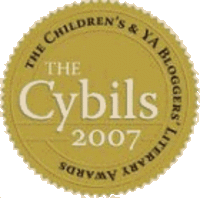
The 2007 Cybils Winners have been announced. You may read about it in full here.
Fantasy and Science Fiction:
Middle: The True Meaning of Smek Day by Adam Rex (This one is way fun!)
Young Adult: Book of A Thousand Days by Shannon Hale (Do I really have to say how much I loved this one? It's Shannon Hale! Need I say more???)
Fiction Picture Book: The Chicken Chasing Queen of Lamar County by Janice N. Harrington. (This is another one that is oh-so-easy to love.)
Middle Grade Novel: A Crooked Kind Of Perfect by Linda Urban. (You can read my interview with Linda Urban.)
Young Adult Novel: Boy Toy by Barry Lyga. (You can read my interview here.
Blog: Becky's Book Reviews (Login to Add to MyJacketFlap)
JacketFlap tags: best of 2007, Add a tag
The American Indian Youth Literature Awards are presented by the American Indian Library Association, an affiliate of the American Library Association. Here are this years winners:
 Picture Book
Picture BookCrossing Bok Chitto: A Choctaw Tale of Friendship and Freedom by Tim Tingle, illustrated by Jeanne Rorex Bridge. Cinco Puntos Press, 2006.
A beautifully inspired story of a friendship between Martha Tom, a Choctaw girl and Li' Mo, a slave boy and how their relationship brought wholeness and freedom to Mo's family and also to many slaves. Bridge's illustrations enhance the story by resonating the joy of friendship, the light of faith, and the leadership of children.
 Middle School
Middle SchoolCounting Coup: Becoming a Crow Chief on the Reservation and Beyond, by Joseph Medicine Crow. National Geographic, 2006.
This appealing autobiography of Dr. Joseph Medicine Crow (Absarokee) is a winner with the young and old. The author recounts his adventures and training as a traditional Crow warrior and his service as a decorated World War II veteran. Walk, run and ride with him as you learn first-hand about real-life on the Crow reservation before during and after encounters with newcomers. In a text that is not preachy, but and honest read, Joseph Medicine Crow tell how he over came many challenges to fulfill is role as Chief of the Crow Nation.
 Young Adult
Young AdultThe Absolutely True Diary of a Part-Time Indian by Sherman Alexie, Little Brown Publishers, 2007.
A realistic, bitter-sweet yet, humorous look at the life of Arnold, a Spokane Indian teenager making his way in life on the reservation while attending an all white high school. Alexie brings to life the challenges many young native people experience as they learn to navigate and balance Indian life in a modern world. Part autobiography, Alexie's Arnold reminds us of the complexities of coming of age, bigotry, bullies, loyalty to family and the meaning of love.
Blog: Becky's Book Reviews (Login to Add to MyJacketFlap)
JacketFlap tags: best of 2007, Add a tag

2008 Gryphon Awards
2008 Winner: Billy Tartle in Say Cheese by Michael Townsend
2008 Honor Books: Spiders by Nic Bishop; Rufus the Scrub Does Not Wear a Tutu by Jaime McEwan
About the award:
The Gryphon Award of $1,000 is given annually in recognition of an English language work of fiction or non-fiction for which the primary audience is children in Kindergarten through Grade 4. The title chosen best exemplifies those qualities that successfully bridge the gap in difficulty between books for reading aloud to children and books for practiced readers.
Blog: Becky's Book Reviews (Login to Add to MyJacketFlap)
JacketFlap tags: best of 2007, Add a tag
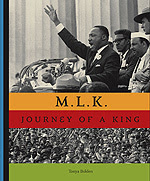
To find out more about the Orbis Pictus Award, click here.
2008 Winner: M.L.K. Journey of a King by Tonya Bolden
2008 Honors: Black and White Airmen: Their True History by John Fleischman; Helen Keller: Her Life In Pictures by George Sullivan; Muckrakers by Ann Bausum; Spiders by Nic Bishop; Venom by Marilyn Singer.
2008 Recommended Reads: 3-D ABC: A Sculptural Alphabet by Bob Razcka; Animals in the House: A History of Pets and People by Sheila Keenan; Clarabelle: Making Milk and So Much More by Cris Peterson; Living Color by Steve Jenkins; The Snow Baby: The Arctic Childhood of Admiral Robert E. Peary's Daring Daughter by Katherine Kirkpatrick; Tracking Trash: Flotsam, Jetsam, and the Science of Ocean Motion by Loree Griffin Burns; The Wall by Peter Sis.
Blog: Becky's Book Reviews (Login to Add to MyJacketFlap)
JacketFlap tags: best of 2007, Add a tag
Wizards Wireless is this month's host of the January Children's Literature Carnival.
To submit carnival posts for next month's carnival of Children's Literature (host to be determined), go to Blog Carnival. And hey, since there's no host yet, maybe you'd like to give it a try. It's a lot of fun. Just contact Melissa Wiley at Here in The Bonny Glen.
Blog: Becky's Book Reviews (Login to Add to MyJacketFlap)
JacketFlap tags: best of 2007, Librarians' Choices, Add a tag
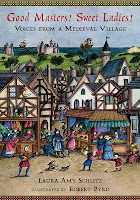
Librarians Choices 2007
About Librarians' Choices
The Librarians' Choices project began as a class assignment in Fall, 2003 at Texas Woman's University, with graduate students in Library Science enrolled in a Book Reviewing class. It has since evolved into a significant professional development activity involving volunteer teachers, librarians, and librarians-in-training associated with the School of Library and Information Studies at TWU. They spent the spring, summer, and fall of 2007, semester reading and discussing hundreds of new books for children and young adults provided by major publishers. In addition, other titles by other publishers were also sought out, read, and discussed. Participants determined which titles were most outstanding based on literary quality, appeal to children and young adults, the typical needs of a school or community library, and a comparative study of other professional review sources. Although we did not have access to ALL the children's and YA books published in 2007, nor did every student read every book as one would expect in a formal review or award committee, we did our best to be comprehensive and thorough.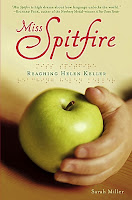 In the end, a limit of 100 titles was set, with approximately half of the list being designated for picture books and half of the list designated for novels. Poetry and nonfiction titles were also incorporated as appropriate. As a culminating activity, each participant chose approximately nine titles to study closely and review. These reviews include a complete bibliography of each title with a description and analysis of the book, as well as connections for sharing the book with child/teen audiences and recommendations for related books to combine or compare with the featured title. The goals of the project are twofold, to develop participant knowledge base about current books for children and young adults and the ability to read and write critically about these books and to use this experience to create a professional resource for others interested in choosing outstanding and intriguing books for the young people they serve.
In the end, a limit of 100 titles was set, with approximately half of the list being designated for picture books and half of the list designated for novels. Poetry and nonfiction titles were also incorporated as appropriate. As a culminating activity, each participant chose approximately nine titles to study closely and review. These reviews include a complete bibliography of each title with a description and analysis of the book, as well as connections for sharing the book with child/teen audiences and recommendations for related books to combine or compare with the featured title. The goals of the project are twofold, to develop participant knowledge base about current books for children and young adults and the ability to read and write critically about these books and to use this experience to create a professional resource for others interested in choosing outstanding and intriguing books for the young people they serve.
Three (soon-to-be four) of the Librarians' Choices lists are available online. Librarians' Choices 2004, Librarians' Choices 2005, Librarians Choices 2006.
For those that are wondering, the list was finalized on December 3, 2007.
Texas Woman’s University
School of Library and Information Studies
Librarians’ Choices 2007
Master List
[Note: As of 1/21/08, the list is still slightly tentative. Meaning that one or two slight changes might be made. But that most of it is good to go. The final, finalized list should be determined later this week.]
Randa Abdel-Fattah's Does My Head Look Big In This?
Sherman Alexie's The Absolutely True Diary of A Part-Time Indian.
Laurie Halse Anderson's Twisted.
Kate Banks' Lenny's Space.
Lynne Barasch's Hiromi's Hands.
Donna M. Bateman's Deep in the Swamp.
Kelly Bingham's Shark Girl.
Nic Bishop's Spiders.
Robin Brande's Evolution, Me & Other Freaks of Nature.
Cecil Castellucci's The Plain Janes.
Gennifer Choldenko's Louder, Lili.
Andrew Clements' No Talking.
Nancy Coffelt's Fred Stays With Me.
Ilene Cooper's The Golden Rule.
Ellie Crowe's Surfer of the Century: The Life of Duke Kahanamoku.
Chris Crutcher's Deadline.
Christopher Paul Curtis' Elijah of Buxton.
Karen Day's Tall Tales.
Jenny Downham's Before I Die.
Sharon Draper's Fire From the Rock.
Ann Dee Ellis' This Is What I Did.
Susan Fletcher's Dadblamed Union Army Cow.
Douglas Florian's Comets, Stars, the Moon, and Mars: Space Poems and Paintings.
John Frank's How To Catch A Fish.
Russell Freedman's Who Was First? Discovering the Americas.
Knock, Knock by Jon Muth, Peter Reynolds, Brett Helquist, Saxton Freymann, Chris Raschka, Tomie de Paola, Yumi Heo, Laurie Keller, Sophie Blackall, Dan Yaccarino, Henry Cole, David Small, Boris Kulikov, Judy Schachner.
Peggy Gifford's Moxy Maxwell Does Not Love Stuart Little.
Gail Giles' Right Behind You.
Emily Gravett's Orange Pear Apple Bear.
Dan Gutman's Casey Back At Bat.
Shannon Hale's Book of A Thousand Days.
Janice N. Harrington's The Chicken-Chasing Queen of Lamar County.
Mette Ivie Harrison's The Princess and the Hound.
Linda Oatman High's The Cemetery Keepers of Gettysburg.
Jennifer L. Holm's Middle School Is Worse Than Meatloaf.
Kimberly Willis Holt's Piper Reed: Navy Brat.
Steve Jenkins' Dogs and Cats.
Peter Johnson's What Happened.
Tony Johnston's Bone by Bone by Bone.
Paula Jolin's In the Name of God.
Sheila Keenan's Animals in the House: History of Pets and People.
Barbara Kerley's Greetings From Planet Earth.
Elizabeth Cody Kimmel's The Top Job.
Jeff Kinney's Diary of A Wimpy Kid.
Katherine Kirkpatrick's The Snow Baby: The Arctic Childhood of Robert E. Peary's Daring Daughter.
Yoon D. Kwon's My Cat Copies Me.
R.L. LaFevers' Theodosia and the Serpents of Chaos.
Julius Lester's Cupid: A Tale of Love and Desire.
Ellen Levine's Henry's Freedom Box.
April Lurie's Brothers, Boyfriends, and Other Criminal Minds.
Barry Lyga's Boy Toy.
Leonard S. Marcus' Pass It Down: Five Picture Book Families Make Their Mark.
Shane Mc G's Tennis Anyone?
Sarah Miller's Miss Spitfire: Reaching Helen Keller.
Shelia P. Moses' Sallie Gal and the Wall-a-kee Man.
Catherine Gilbert Murdock's The Off Season.
Deborah Noyes' Red Butterfly: How A Princess Smuggled the Secret of Silk Out of China.
Linda Sue Parks' Tap Dancing On the Roof.
Gary Paulsen's Lawn Boy.
Mal Peet's Tamar.
Jean E. Pendziwol's Marja's Skis.
Sara Pennypacker's The Talented Clementine.
Mitali Perkins' Rickshaw Girl.
Cris Peterson's Clarabelle: Making Milk and So Much More.
Laura Resau's Red Glass.
Cal Ripken's The Longest Season.
Amy Krouse Rosenthal's The OK Book.
Robert Sabuda's Encyclopedia Prehistorica: Mega-Beasts.
Lisa Ann Sandell's Song of the Sparrow.
Laura Amy Schlitz's Good Masters! Sweet Ladies! Voices From A Medieval Village.
Gary D. Schmidt's The Wednesday Wars.
Editor, Ariel Schrag's Stuck in the Middle: 17 Comics from an Unpleasant Age.
Elaine Scott's When Is A Planet Not A Planet? The Story of Pluto.
Laura Vaccaro Seeger's First the Egg.
Brian Selznick's The Invention of Hugo Cabret.
Robert Sharenow's My Mother the Cheerleader.
Kathy Shaskan's How Underwear Got Under There: A Brief History.
Bob Shea's New Socks.
Joyce Sidman's This Is Just To Say: Poems of Apology and Forgiveness.
Peter Sis' The Wall: Growing Up Behind the Iron Curtain.
Anita Sitarski's Cold Light: Creatures, Discoveries, and Inventions That Glow.
Alexandra Siy's Sneeze.
Jordan Sonnenblick's Zen and the Art of Faking It.
Rebecca Stead's First Light.
George Sullivan's Helen Keller: Her Life In Pictures.
Shaun Tan's The Arrival.
Lauren Tarshis' Emma Jean Lazarus Fell Out Of A Tree.
Peter Lane Taylor's The Secret of Priest's Grotto: A Holocaust Survival Story.
James Otis Thach's A Child's Guide To Common Household Monsters.
Linda Urban's A Crooked Kind of Perfect.
C.G. Watson's Quad.
Carole Boston Weatherford's Birmingham, 1963.
Lee Weatherly's Kat Got Your Tongue.
Rosemary Wells' Max Counts His Chickens.
Ruth White's Way Down Deep.
Mo Willems' Knuffle Bunny Too: A Case of Mistaken Identity.
Valerie Worth's Animal Poems.
Dan Yaccarino's Every Friday.
Sara Zarr's Story of A Girl.
Gabrielle Zevin's Memoirs of a Teenage Amnesiac.
Blog: Becky's Book Reviews (Login to Add to MyJacketFlap)
JacketFlap tags: best of 2007, Add a tag
The Mystery Writers of America have announced their shortlists for the 2008 Edgar Awards. Here are the Children's and YA nominees. I've only read one of the 'juvenile' titles: THE NAME OF THIS BOOK IS SECRET. (A book that I loved and ranked among my favorites of the year.) And I've read three of the YA titles: DIAMONDS IN THE SHADOW, TOUCHING SNOW and BLOOD BROTHERS. (RAT LIFE was one of the Cybils nominated books that I never got to reading.)
Juvenile
The Name of This Book is Secret by Pseudonymous Bosch
Shadows on Society Hill by Evelyn Coleman
Deep and Dark and Dangerous by Mary Downing Hahn
The Night Tourist by Katherine Marsh
Sammy Keyes and the Wild Things by Wendelin Van Draanen
YA
Rat Life by Tedd Arnold (Penguin - Dial Books for Young Readers)
Diamonds in the Shadow by Caroline B. Cooney
Touching Snow by M. Sindy Felin
Blood Brothers by S.A. Harazin
Fragments by Jeffry W. Johnston
Blog: Becky's Book Reviews (Login to Add to MyJacketFlap)
JacketFlap tags: best of 2007, Add a tag
The 2008 Notable Children's Books list has been published. This list selects "notable" books for children from birth to age 14. It is divided into Younger Readers, Middle Readers, Older Readers, and All Ages.
Blog: Becky's Book Reviews (Login to Add to MyJacketFlap)
JacketFlap tags: best of 2007, Add a tag
Here is YALSA's Top 10 of the year.
The Absolutely True Diary of A Part-Time Indian, Sherman Alexie.
A Long Way Gone: Memoirs of a Boy Soldier, Ishmael Beah.
Before I Die, Jenny Downham
Your Own, Sylvia: A Verse Portrait of Sylvia Plath, Stephanie Hemphill
Mister Pip, Lloyd Jones
Skulduggery Pleasant, Derek Landy
Tamar: A Novel of Espionage, Passion, and Betrayal, Mal Peet
American Shaolin: Flying Kicks, Buddhist Monks and the Legend of Iron Crotch: An Odyssey in the New China, Matthew Polly
The Invention of Hugo Cabret, Brian Selznick
The Arrival, Shaun Tan.
To read their full list, visit their Best Books for Young Adults page. Of special note, I see Miss Spitfire by Sarah Miller has made the list!!! That is exciting news indeed.
Blog: Corazonadas (Login to Add to MyJacketFlap)
JacketFlap tags: best of 2007, best of 2007, Add a tag
However, I did mention in my December post the title of Margarita Engle’s The Poet slave of Cuba. What I didn’t say was that from the moment I read it, I knew it would win the Pura Belpre Medal and more. Why? Because it is powerful! Have you read this book? Careful, because you might never forget it:
there’s a poet who can wiggle his ears and
one who challenges me to finish his verses
after he leaves the words soaring
like birds in midair
You’ve won, they tell me,
Poeta-Esclavo, you’ve won
and it feels good,
how they turned the words poet and slave
into a name, first name and the last name so that
when a man is my friend
he only uses the first part
calling me Poet
not Slave
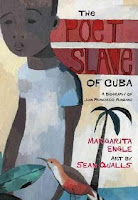
In addition here are other three books I have collected and admired, written or illustrated by Latinos and published in 2007, and worth plenty of attention: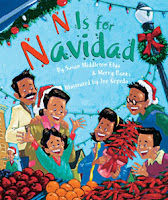
N is for Navidad, by Susan Middleton Elya, Merry Banks, illustrated by Joe Cepeda
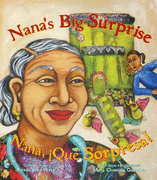 Nana's Big Surprise/Nana, ¡Qué Sorpresa! By Amada Irma Pérez, illustrated by Maya Christina Gonzalez
Nana's Big Surprise/Nana, ¡Qué Sorpresa! By Amada Irma Pérez, illustrated by Maya Christina Gonzalez 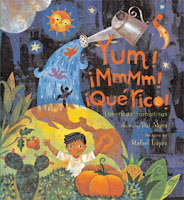 Yum! Mmmm! Que Rico!: America's Sproutings. By Pat Mora, illustrated by Rafael López
Yum! Mmmm! Que Rico!: America's Sproutings. By Pat Mora, illustrated by Rafael López Blog: Becky's Book Reviews (Login to Add to MyJacketFlap)
JacketFlap tags: best of 2007, Add a tag

2008 Awards and Honors
Newbery Medal Winner: Good Masters! Sweet Ladies! Voices From a Medieval Village by Laura Amy Schlitz.
Newbery Honor books: Elijah of Buxton by Christopher Paul Curtis, The Wednesday Wars by Gary D. Schmidt, Feathers by Jacqueline Woodson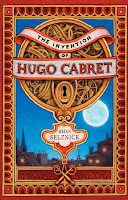 Caldecott Medal Winner: The Invention of Hugo Cabret by Brian Selznick
Caldecott Medal Winner: The Invention of Hugo Cabret by Brian Selznick
Caldecott Honor Books: Henry's Freedom Box by Ellen Levine, illustrated by Kadir Nelson; First the Egg by Laura Vaccaro Seeger; The Wall: Growing Up Behind the Iron Curtain by Peter Sis; Knuffle Bunny Too: A Case of Mistaken Identity. Coretta Scott King Book Award Winner (Author Category): Elijah of Buxton by Christopher Paul Curtis
Coretta Scott King Book Award Winner (Author Category): Elijah of Buxton by Christopher Paul Curtis
Honor books: November Blues by Sharon M. Draper; Twelve Rounds to Glory: The Story of Muhammad Ali by Charles R. Smith
Coretta Scott King Book Winner (Illustrator category): Let It Shine by Ashley Bryan
Honor books: The Secret Olivia Told Me by N. Joy, illustrated by Nancy Devard; Jazz On A Saturday Night by Leo and Diane Dillon.
Coretta Scott King/John Steptoe New Talent Author Award: Brendan Buckley's Universe and Everything In It by Sundee T. Frazier
Schneider Family Book Award: (age 11-13) Reaching for Sun by Tracie Vaughn Zimmer (age 13-18) Hurt Go Happy by Ginny Rorby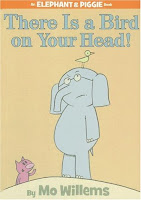 Theodor Seuss Geisel Award Winner: There Is A Bird On Your Head! by Mo Willems
Theodor Seuss Geisel Award Winner: There Is A Bird On Your Head! by Mo Willems
Honor Books: First the Egg by Laura Vaccaro Seeger; Hello, Bumblebee Bat by Darrin Lunde; Jazz Baby by Lisa Wheeler; Vulture View by April Pulley Sayre.
Margaret A. Edwards Award Winner: (Lifetime Achievement) Orson Scott Card. (Yes, you heard me ORSON SCOTT CARD) (Ender's Game and Ender's Shadow)
Pura Belpre Award: Yuyi Morales illustrator of Los Gatos Black on Halloween by Marisa Montes; Margarita Engle author of The Poet Slave of Cuba: A Biography of Juan Francisco Manzano, illustrated by Sean Qualls.
Honor books (illustrator): My Name Is Gabito: The Life of Gabriel Garcia Marquez illustrated by Raul Colon, written by Monica Brown; My Colors, My World by Maya Christina Gonzalez.
Honor books (author): Frida: Viva la vida! Long Live Life by Carmen T. Bernier-Grand; Martina the Beautiful Cockroach: A Cuban Folktale by Carmen Agra Deedy; Los Gatos Black on Halloween by Marisa Montes. Robert F. Sibert Informational Book Medal Winner: The Wall by Peter Sis
Robert F. Sibert Informational Book Medal Winner: The Wall by Peter Sis
Honor Books: Lightship by Brian Floca; Nic Bishop Spiders by Nic Bishop
Michael L. Printz Award Winner: The White Darkness by Geraldine McCaughrean
Honor Books: Dreamquake by Elizabeth Knox; One Whole and Perfect Day by Judith Clarke; Repossessed by A.M. Jenkins; Your Own Sylvia by Stephanie Hemphill
Mildred L. Batchelder Award: Brave Story by Miyuki Miyabe (translated by Alexander O. Smith
Honor books: The Cat: Or How I Lost Eternity by Jutta Richter (translated by Anna Brailovsky); Nicholas and the Gang by Rene Goscinny (translated by Anthea Bell)
Odyssey Award for Excellence in Audiobook Productions Winner: Jazz
Honor titles: Bloody Jack: Being An Account of the the Curious Adventures of Mary 'Jacky' Faber; Ship's Boy; Dooby Dooby Moo; Harry Potter and the Deathly Hallows; Skulduggery Pleasant; Treasure Island.
View Next 20 Posts















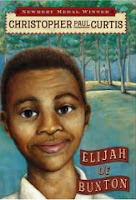
That all looks like so much fun! I especially love the spoon collection
Thanks Anamaria, yes the spoon collection is much to be admired (I didnt’ realise I had such treasures lurking in the bottom of my “throw-it-all-in-there” cutlery drawer!
(I didnt’ realise I had such treasures lurking in the bottom of my “throw-it-all-in-there” cutlery drawer!
Wow wow wow! Fantastic!
Thanks Candy. Watch out for killer cakes coming your way!